#HMS St. Lawrence
Explore tagged Tumblr posts
Text
Bill Johnston - The Thousand Islands Pirate
Subscriber Content Add content here that will only be visible to your subscribers. Payment Image: Portrait of William “Pirate Bill” Johnston, 1840. Benson Lossing drew the portrait. Bill Johnston – The Thousand Islands Pirate Bill Johnston was a Canadian-American smuggler, river pirate, and War of 1812 privateer. Born in Canada on February 1, 1782, Johnston had been accused of spying in…
#1800s#Bandit#Battle of Crysler&039;s Farm#Battle of the Windmill#Bill Johnston#History Daily#HMS St. Lawrence#kingston#Lake Ontario#NY#Ontario#Pirate#Royal Navy#Sacketts Harbor#Smuggler#The ship Sir Robert Peel#Upper Canada Rebellion 1837#US Navy#War of 1812
0 notes
Text
I am thinking about the largest and most powerful ships that participated in the War of 1812, and I wondered what was the highest-rated Royal Navy warship in the conflict (see also: comparative sizes of ships of the line).
There were a few 3rd rate ships involved: HMS Africa was part of the British squadron that chased USS Constitution, and HMS Poictiers rescued the Frolic from USS Wasp. The flagship of the North American station around this time period was only a 4th rate, HMS Newcastle.
And then I remembered: not only was there a 1st rate ship of the line in the War of 1812, she was built and sailed on Lake Ontario!!

HMS St Lawrence: the only first-rate Royal Navy ship of the line built on fresh water (Wikimedia Commons). She carried 102 guns(!), but never saw action in the war.
#war of 1812#royal navy#military history#hms st lawrence#great lakes#lake ontario#1810s#age of sail#line of battle ship#between hms st lawrence and uss fulton there were a lot of crazy naval battles narrowly missed#maritime history
50 notes
·
View notes
Text
Today in History - USS Constitution vs. HMS Guerriere 19. August 1812
On 2 August 1812, the USS Constitution (44guns) set sail from Boston and headed east in the hope of finding some British ships. After failing to encounter any British ships, the Constitution sailed along the coast of Nova Scotia, then to Newfoundland and finally stopped off Cape Race in the Gulf of St Lawrence. Here the Americans captured and burned 2 brigs of little value. On 15 August, the Constitution recaptured an American brig from the British sloop HMS Avenger, but the British ship escaped. Captain Issac Hull put a crew on the brig and sailed her back to an American port.
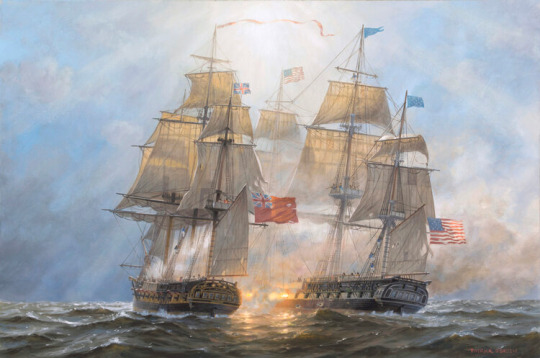
USS Constitution vs HMS Guerriere, by Patrick O'Brien (x)
At 14:00 on 19 August, the crew of the Constitution made out a large sail, which turned out to be the British frigate HMS Guerriere (38guns), led by Captain James Dacres. At 16:30, the two ships began to position themselves and raise their flags. At 17:00, the Guerriere opened fire with her weather guns, with shots hitting the water just ahead of the American ship. They then fired their port broadside, 2 of these shots hitting the American ship, the rest going over and through the rigging. As they prepared to fire again, the Constitution fired her port guns. The two ships were at some distance from each other, and for the next 60 minutes they continued in this manner, with no damage to either ship.
At 18:00 they moved closer together, and by 18:05 the two ships were within pistol range of each other. A furious cannonade began, and at 18:20 the Constitution blew away the Guerriere's mizzenmast. The Constitution came around the Guerriere's bow and fired a heavy barrage that blew away the British frigate's main yard. The Americans approached once more and fired on the Guerriere. The British ship's mizzenmast was now dragging in the water and the two ships came close. The British bow guns damaged the Constitution's great cabin, where a fire even broke out.
It was about here that both crews tried to board the other ship, or at least thought about it. And it was also the place where most of the Constitution's casualties occurred. In fact, both sides suffered heavily from musket fire at this point. On the Guerriere the casualties were much greater. Dacres was shot in the back as he urged his crew to fight. Eventually the ships broke away from each other and then the Guerriere's foremast and mainmast came down, leaving the British ship defenceless.

USS Constitution (44) vs HMS Guerriere (38) in action on the 19th of August, 1812, by Tom Freeman (x)
At 18:30 the Constitution ran down a little and made repairs which took only a few minutes. At 19:00 Hull watched as the Guerriere surrendered, unable to continue the fight.
Guerries's Captain Dacres was escorted aboard the Constitution. Hull refused to accept Dacres' surrender rapier, as he could not accept the rapier of a man who had fought so bravely. He also ordered that Dacres' mother's Bible be returned to him. The Guerriere was clearly sinking, and the wounded were transferred to the Constitution. Hull found that ten impressed Americans had served aboard the Guerriere, but Dacres had allowed them to remain below decks rather than fight their countrymen.
Hull wanted the Guerriere towed in as a prey ship. The Constitution lay with the Guerriere that night, but by daybreak it was clear that the Guerriere could not be salvaged. The prisoners and the American salvage party were taken aboard the Constitution, and at 3 p.m. the Guerriere was set on fire and soon exploded.
Although the Constitution was essentially undamaged and still had two-thirds of its ammunition, the guerrilla's shot became wedged in the frigate's lower masts and the Constitution could not continue her voyage. Hull also wanted to inform the American public of the victory. He reached Boston ten days later, and his message (with the apparent evidence of more than two hundred prisoners of war) provoked cheers. The Guerriere was one of the Royal Navy's most active ships in stopping and searching American merchant ships, and news of her defeat was particularly gratifying to the American seafaring community.
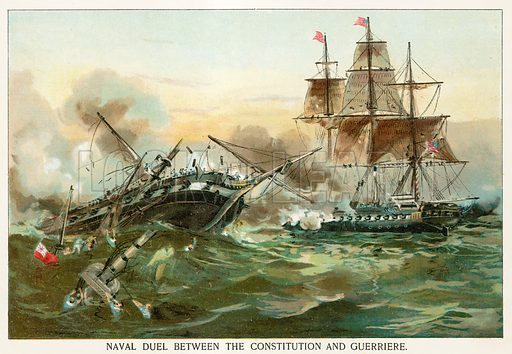
Naval duel between the Constitution and Guerriere. Illustration from Columbus and Columbia (Manufacturers' Book Co, c 1890) (x)
After all the Americans lost 7 men, while the British lost their ship, had 15 killed, 78 wounded 257 captured. This, of course, led to Captain Dacres being court-martialled after his release in a prisoner exchange and his return to Halifax, as was customary in the case of a Royal Navy ship lost for any reason. He put forward as his defence the facts that the Guerriere was originally French-built and therefore not as sturdy as British-built ships, and that the Guerriere was badly decayed and on her way to refit in Halifax at the time, and the fall of the mizzen mast which crippled the Guerriere early in the fight had been due as much to rot as battle damage.There was no suggestion that Dacres and his men had not done their utmost, or that Dacres had been unwise to engage the Constitution. He was therefore honourably acquitted of all blame for the loss.
Dacres continued to serve in the navy after his acquittal, and was promoted to vice-admiral on 20 March 1848. He later died on 4 December 1853.
Hull left Constitution in September 1812, when a death in his family required his attention. He later commanded the Boston, Portsmouth, and Washington navy yards, served on the Board of Naval Commissioners, and commanded the Mediterranean and Pacific Squadrons. He died in Philadelphia on February 13, 1843.
#naval history#today in history#uss contitution vs hms guerriere#19 august 1812#war of 1812#age of sail
56 notes
·
View notes
Text
James Cook
1728 – 1779
1755: Eintritt in die britische Königliche Marine.
1763–1767: Kartografierung der Küste Neufundlands und Vermessung des St.-Lawrence-Stromes.
1768–1771: Erste Weltumsegelung (HMS Endeavour), Beobachtung des Venustransits auf Tahiti, Umsegelung Neuseelands und Entdeckung der Ostküste Australiens.
1772–1775: Zweite Weltumsegelung, Vorstoß bis an die Packeisgrenze der Antarktis, Widerlegung der Existenz eines großen Südkontinents in bewohnbaren Breiten.
1776–1779: Dritte Weltumsegelung auf der Suche nach der Nordwestpassage.
1778: Als erster bekannter Europäer erreicht er die Hawaii-Inseln.
1779: Tötung auf Hawaii während eines Konflikts mit Einheimischen.
0 notes
Note
lawrence asks,,, hm. if you have any thoughts on it, I wld like to hear the most vulnerable lawrence has been w adam post-bathroom? we've both talked abt it b4, & since he tends to fall into the habit or bottling his emotions up/struggles to bring up smth that's bothering him, how wld such an event occur? idk I'm just very weak for soft hurt/comfort,, other than that tho! what are some of your favourite parallels he has, regardless if they're based in canon or not? (I hope you have a better day tmrw also,,)
ooghdhfh,,,, hmmmm
I think. nd I know I just extremely briefly touched on it but I think it comes after Daniel is recovered. in a world where the traps play out relatively the same, yknow? bc I think there’s a whole… like if Lawrence had just had the, idk, divine fucking foresight and used his one bullet to shoot John then hey, another kid wouldn’t have been fucking tortured + lost his father. but instead Lawrence put a hole through the shoulder of the man he loves.
obviously I think hearing news about traps in general is hard for both of them, but I think hearing about Daniel specifically would send Lawrence down SUCH a spiral. bc he is a father and Diana was tortured by Jigsaw too but not nearly to such extremes and at least Diana still has both her parents. and I think it would be very hard for Lawrence to ignore that voice in the back of his head going “if you’d just been smarter, none of this ever would’ve happened. that boy wouldn’t be traumatized, his father wouldn’t be missing, and Adam wouldn’t be nearly as hurt. it’s all your fault.”
which of course it isn’t. But Lawrence is very good at 1) bottling up his emotions, and 2) spiraling. bc I think he’s the kind of person to debate himself and when his mind only wants to make him feel worse, Well. i don’t think this necessarily ends in an explosion, more likely Adam comes home, mentions off-hand that “that Matthews kid is being released from the hospital, thank god.” — and ofc he knows Lawrence has been distant and moody but they both get that way having to listen to reports and speculation on Jigsaw like he’s some kind of fucking celebrity. so I do think it’s kind of a surprise when Lawrence just. looks up at Adam and tries to smile and can’t get any words out. because what can he say? (what excuse could he possibly give when, certainly, Adam is thinking the exact same thoughts he is?)
except, y’know, Adam isn’t thinking those thoughts, and it takes some coaxing to get Lawrence to admit what’s got him shaking so bad. they wind up on the kitchen floor cause there’s just no way they’re making it to the couch and when Lawrence can finally breathe again, after listening to Adam quietly assure him he could Never blame Lawrence for what happened— Adam’s fingers stroking up and down his spine, his own clutching the fabric of Adam’s shirt tight, Adam just, completely seriously: “if I ever see him I will kill Jigsaw for what he did to you.”
and Lawrence can only nod, because what can he say to that? Especially when he’s not at the stage where he sees himself worthy of compassion all the time, let alone anger. The idea that someone loves him enough to fight for him is. Mmnfh.
(Adam follows it up with “seriously, I don’t care if I’m just identifying a body, I’ll bring him back to life and fucking kill him again!” which gets a laugh like he’d hoped it would. “You’d find a way.” Lawrence smooths out Adam’s shirt, finally cracking a smile as Adam nods: “Fuck yea I’d find a way. For you.”)
+ oofhdjfidjjfhs obviously I love all the religious parallels he has… it’s not rlly a PARALLEL per se but as we’ve discussed i heavily associate him w sheep! 🐏 bc he is Soft n Huggable Like Sheep :’3
I also associate him w Lavender. ummnn and bc im thinking abt it!! when I was assigning birth flowers for William’s tattoos, I gave Lawrence 6/26 as his birthday! which makes his flower Honeysuckle (devotion, pure happiness) but also makes him a Cancer sun! his birthday is also a feast day for St. Norbert of Xanten, who is a patron saint against birth complications + for peace. His birth cards are Temperance + The Hierophant, which share a passionate nature, concern for purity of intention + faith in perfectability. Both are impatient with wrong-doing + lack of effort. They can be both trusted leaders and loyal followers (hmmmm… sound familiar? sjfhdhd). OH and June actually has 3 birthstones (pearl, moonstone, + alexandrite) but I lean towards Alexandrite since it’s been used for healing + is believed to bring good luck (I don’t have a lot of experience w/ Alexandrite + tend to take online crystal guides with a grain of salt, tho lol)
5 notes
·
View notes
Text

recompense - Victor feat. Lawrence
@dxsole
tw: torture, body horror, gore, n.sft / n.sfw, talk of gender dysphoria and self harm
All done, all finished with her, now; she was laid out on the floor off to the side of the room to be disposed of later, her guts strewn along the floor in a tidy, nearly three-foot-deep radius around her, thick lines following imaginary patterns and shapes across the easy-to-clean tiles until the string ran out. The average adult’s small & large intestine, when combined, could range anywhere from fourteen to twenty-one feet long, and Victor had wanted to play around with every inch of it. Wrap her ribs up in them. See her dead heart nestled softly behind her small, slimy lungs. She was so sweet, too. With pretty, icy-blue eyes.
"Baby,” Victor croons the closer Lawrence stalks to him, dual-colored eyes sharp and bright and Argus-style riveted, “baby, baby, baby...” Fingers, arms, every bit of Victor’s clothes smeared with dried or drying blood and Victor cups Lawrence’s jaw and holds him back for just a moment, restricts him, and sees the irritation jump in a muscle in Argus’ cheek at the silent command, but Victor has ink smoothing up the thick column that is the inside of his throat. He wants to share a story.
“Baby��� Sweetheart, I want you so bad right now but I also wanna…tell you somethin’. Will you listen?” Victor’s already removing his belt, regardless. “Will you give me your eyes, baby? And your ears? Hm? I wanna tell you…” the shudder that runs through him as Argus’ sure fingers press over the familiar, taut plane of Victor’s scarred belly, the three small incisions on his mind in particular. “I wanna tell you about…the first girl I ever killed.”
“This blue-eyed girl,” Victor purrs with a nod, “you see what she had stuck in her? You see me pull it out of her?” Victor’s maw—the space around his nose, his mouth, twitches up into a disgusted, wry snarl as Argus agrees and starts palming him, smoothing fingers over the wet slick that’s by now slid down Victor’s thighs.
“One of those nasty strings,” Vic shuddered again, Argus’ bloody fingers pressing into him and Victor finds refuge in the enucleation table again, the headlock spot filled with blood but the remainder of the table mostly spotless.
Victor had worked on the floor with this one, for most of the time. Because—
“Feminine product. Hm? Fucking disgusting, wasn’t it? Her body didn’t wanna give it to me, she was clenched up so tight from what you did to her… You choked her up so good…” Victor moans the last bit, his voice breathy and low as Argus curls his fingers. If he didn’t know any better, Victor would guess Lawrence was trying to shut him up, but Vic wanted to say this. He thinks he could be dying and still want to say this to Lawrence, in fact. This story. But he has to explain a little, where it’s coming from, even if Argus knows. He knows; he knows. But not completely. He wasn’t there. He didn’t know enough.
“Finally cut it out of her, after she was on the ground and in shock… Hardly moved…” Victor licked his lips and he reaches down to hold Lawrence’s wrist, two fingers pressed deep and bloody inside of him and Victor’s breath hitches, holding Argus still for a moment and grinding down against his palm. “Fuck, I just want… M’almost there…” He slows down his pace, rutting slower, his vision coming and going from all the extra stimulation—and maybe his high from earlier is fucking with him, too. His nose still itches over it, which is as unusual. A throaty grunt and Victor tries to collect his thoughts again.
“The fucking tampon, I know it’s a dirty word, I know it’s gross; baby, listen!” Victor’s hands move up to Argus’ throat and Argus was never a fan of that. Victor doesn’t grip, at all, he only holds, he shudders and shakes because he’s right on the edge but he doesn’t squeeze at Lawrence’s throat. He exhales sharply and shudders again. The room is so bright and smells like death. It’s the tampon blood, Victor can still smell it especially.
“Used to hate blood. Can you believe that? Me?” Cheshire grin, popcorn teeth of silver and gold caps, dying teeth that need attention, numbed with vodka and the occasional 8ball. “But then I wanted that girl dead…and I changed my mind about it…” Sleepily, turned on, Victor grabs for Argus, having been so patient for him, pulls him closer by the belt and gets him out of his slacks as a teasing reward for listening so far.
“She wanted to die, too. She wasn’t that old, but she wanted it… Eleven, maybe. Twelve...” His fingers cover Argus’ tip, smearing the sticky pre over his fingertips before bringing his fingers to his lips to lick them off. Fuck, he always tasted so good. Perfect, actually, especially if he’d had a lot of fruits and natural sugars lately… Argus pushes him up the enucleation table and Victor grins like a hungry lion and traps Argus with his legs around his waist.
“She was barely bleeding from her cunt when I cut her thighs open for her. Hm?” His voice is shaking. It’s obvious, now, isn’t it? Is it? Argus knew when he started killing. Or maybe he didn’t. Maybe he didn’t know. “Y’know? You get it?” Maybe the tampon was getting to him. Was that a thing? That distinct, thick scent of menstruation blood they say nobody else can really smell as much as you can. Maybe it got to his head and unlocked it all again.
Argus presses into him, a bit sloppy, still nodding his head, all long, hard a’s and clipped syllables, his natural voice. Argus in full. Victor pants and imagines he’s a little more dry than he usually might be. Spits into his hand and smears it between them. His mouth is dry, too.
“Baby,” Victor says, reaching for one of Argus’ hands sat next to him for support and setting his fingers over one of his thighs, over the thin, thin scars he’s traced over half a dozen times and criss-crossed overtop of just as much. Victor’s light-headed. “I want you to know…” Lawrence’s left iris so much lighter than his right. Victor holds his gaze hostage and clenches down around him so that he’ll pay attention for sure and listen.
“Her name was Ophelia, okay? Ophelia.” His eyes hurt. He sort of forgot what crying felt like, especially while high. Knives. “And I killed her, but she’s okay now. She doesn’t have to have any of those—nasty strings in her or-or anything. And that’s all. I just…wanted you to know that. Please make me come, I can’t take it, I don’t miss her at all, not fucking at all, but it still—hurts, knowing she had to suffer before I—saved her ‘n everything; there! Oh, there, there, there, there—��
#[ vic had ALL of his legal documents and records redacted and changed…#newspapers in archives… he was Rich!! ]#[ and he wanted to talk abt it!! :// ]#otp: in the eye of the beholder#long post.#drabble#headcanon: victor#study: victor#read the warnings#ooc#dxsole ( larry )
4 notes
·
View notes
Text
The Battle of the Plains of Abraham
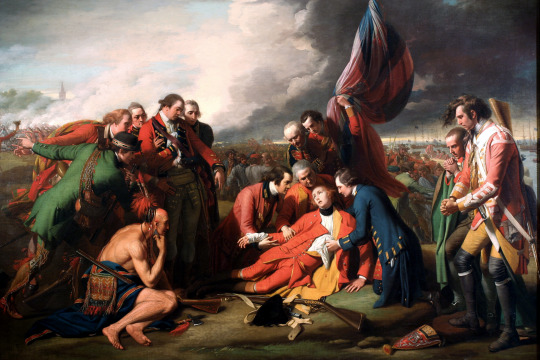
Today, September 13, in 1759 the battle of the Plains of Abraham takes place between British and French forces outside the city of Quebec, Canada. It is generally considered the decisive engagement of the French and Indian War, the North American theatre of the global Seven Years War.
In 1759 British and British-American colonial forces laid siege to the vital French-Canadian town of Quebec, on the Saint Lawrence. Through the summer siege illness spread rapidly through the British camps. In August the commander of the British forces, General James Wolfe, was himself bedridden, causing already low morale to slump even further among the British troops. With many men in camp hospitals, British fighting numbers were thinned, and Wolfe personally felt that an attack on the town was needed by the end of September, or Britain's opportunity would be lost. In addition, his frustration with the defensive stance of the French commander, Montcalm, continued to grow. In a letter to his mother, Wolfe wrote, "The Marquis of Montcalm is at the head of a great number of bad soldiers, and I am at the head of a small number of good ones that wish for nothing so much as to fight him; but the wary old fellow avoids an action, doubtful of the behaviour of his army." Montcalm also expressed frustration over the long siege, relating that he and his troops slept clothed and booted, and his horse was always saddled in preparation for an attack.
After considering and rejecting a number of plans for landings on the north shore of the Saint Lawrence, a decision was made in late August by Wolfe and his brigadiers to land upriver of the city. If successful, such a landing would force Montcalm to fight, as a British force on the north shore of the St. Lawrence would cut his supply lines to Montreal. Initial suggestions for landing sites ranged as far as 32 kilometres (20 mi) up the St. Lawrence, which would have given the French troops one or two days to prepare for the attack. Following the failed British assault on Montmorency, Montcalm altered his deployment, sending Bougainville and a column of approximately 1,500 regular troops, 200 cavalry, and a group of New French militia—some 3,000 men in all—upriver to Cap-Rouge to monitor the British ships upstream. He further strengthened his defences of the Beauport shore following the abandonment of the British camp at Montmorency, which he regarded as preparations for a descent (amphibious attack) on Beauport. In spite of warnings from local commanders, he did not view an upstream landing as a serious possibility.
The British, meanwhile, prepared for their risky deployment upstream. Troops had already been aboard landing ships and drifting up and down the river for several days when Wolfe on 12 September, made a final decision on the British landing site, selecting L'Anse-au-Foulon. L'Anse-au-Foulon is a cove situated west of the city, three kilometres upstream from Cap Diamant. It lies at the bottom of a 53-metre (174 ft) high cliff leading to the plateau above, and was protected by a battery of guns. It is not known why Wolfe selected Foulon, as the original landing site was to be further up the river, in a position where the British would be able to develop a foothold and strike at Bougainville's force to draw Montcalm out of Quebec and onto the plains. Brigadier-General George Townshend wrote that "by some intelligence the General had, he has changed his mind as to the place he intended to land". In his final letter, dated HMS Sutherland, 8:30 p.m. 12 September, Wolfe wrote:
I had the honour to inform you today that it is my duty to attack the French army. To the best of my knowledge and ability, I have fixed upon that spot where we can act with most force and are most likely to succeed. If I am mistaken I am sorry for it and must be answerable to His Majesty and the public for the consequences.
Wolfe's plan of attack depended on secrecy and surprise. His plan required that a small party of men should land by night on the north shore, climb the Promontory of Quebec, seize a small road, and overpower the garrison that protected it, allowing the bulk of his army (5,000 men) to ascend the cliff by the small road and then deploy for battle on the plateau. Even if the first landing party succeeded in their mission and the army was able to follow, such a deployment would still leave his forces inside the French line of defense with no immediate retreat but the river. It is possible that Wolfe's decision to change the landing site was owing less to a desire for secrecy and more to his general disdain for his brigadiers (a feeling that was reciprocated); it is also possible that he was still suffering the effects of his illness and the opiates he used as painkillers. Historians believe Wolfe ordered the attack believing the advanced guard would be repulsed, and anticipated dying gallantly with his men rather than returning home in disgrace.
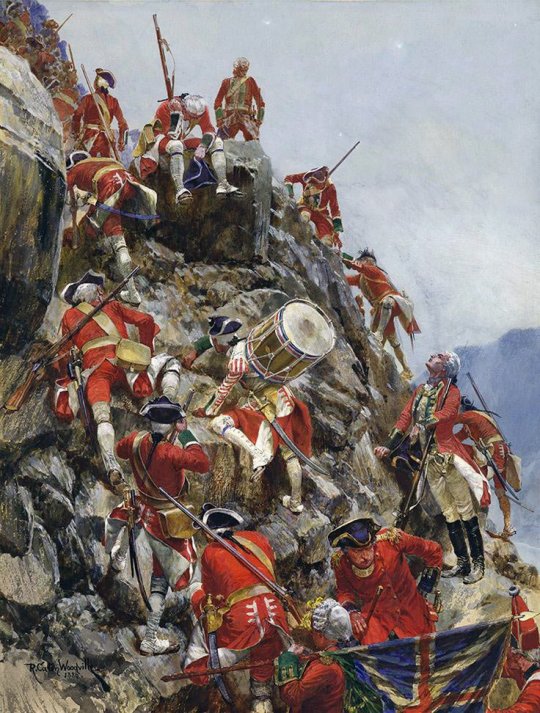
Bougainville, tasked with the defence of the large area between Cap Diamant and Cap Rouge, was upstream with his troops at Cap Rouge on the night of 12 September, and missed seeing numerous British ships moving downstream. A camp of approximately 100 militia led by Captain Louis Du Pont Duchambon de Vergor, who had unsuccessfully faced the British four years previously at Fort Beauséjour, had been assigned to watch the narrow road at L'Anse-au-Foulon which followed a streambank, the Coulée Saint-Denis. On the night of 12 September and morning of 13 September, however, the camp may have contained as few as 40 men, as others were off harvesting. Vaudreuil and others had expressed their concern at the possibility of L'Anse-au-Foulon being vulnerable, but Montcalm dismissed them, saying 100 men would hold off the army until daylight, remarking, "It is not to be supposed that the enemies have wings so that they can in the same night cross the river, disembark, climb the obstructed acclivity, and scale the walls, for which last operation they would have to carry ladders."
Sentries did detect boats moving along the river that morning, but they were expecting a French supply convoy to pass that night—a plan that had been changed without Vergor being notified. When the boats, loaded with the first wave of British troops, were challenged, a French-speaking officer, either a Captain Fraser or Captain Donald McDonald of the 78th Fraser Highlanders, was able to answer the challenge in excellent French, allaying suspicion.
The boats, however, had drifted slightly off course: instead of landing at the base of the road, many soldiers found themselves at the base of a slope. A group of 24 volunteers led by Colonel William Howe with fixed bayonets were sent to clear the picket along the road, and climbed the slope, a maneuver that allowed them to come up behind Vergor's camp and capture it quickly. Wolfe followed an hour later when he could use an easy access road to climb to the plain. Thus, by the time the sun rose over the Plains of Abraham, Wolfe's army had a solid foothold at the top of the cliffs of the promontory of Quebec.
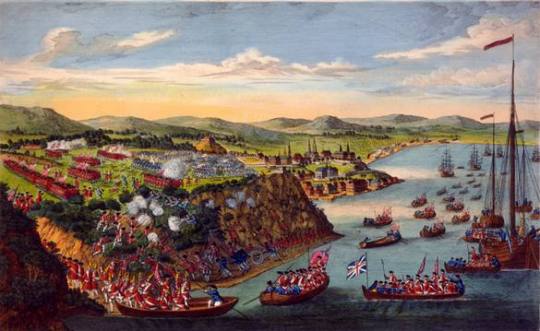
The plateau was undefended save for Vergor's camp, as Vaudreuil had ordered one of the French regiments to relocate to the east of the city not long before the landing. Had the immediate defenders been more numerous, the British might have been unable to deploy or even been pushed back. An officer who would normally have patrolled the cliffs regularly through the night was unable to on the night of the 12th because one of his horses had been stolen and his two others were lame. The first notice of the landing came from a runner who had fled from Vergor's camp, but one of Montcalm's aides felt the man was mad and sent him away, then went back to bed. Saunders had staged a diversionary action off Montmorency, firing on the shore emplacements through the night and loading boats with troops, many of them taken from field hospitals; this preoccupied Montcalm.
The British under General Wolfe attacking the heights of Quebec, 1759 Montcalm was taken aback to learn of the British deployment, and his response has been regarded as precipitate. Though he might have awaited reinforcement by Bougainville's column (allowing simultaneous frontal and rear attacks on the British position) or avoided battle while he concentrated his forces, or even yielded the city to Wolfe, he instead elected to confront Wolfe's force directly. Had he waited, the British would have been entirely cut off—they had nowhere to go but back down the Foulon, and would have been under fire the entire way. To an artillery officer named Montbelliard, Montcalm explained his decision thus: "We cannot avoid action; the enemy is entrenching, he already has two pieces of cannon. If we give him time to establish himself, we shall never be able to attack him with the troops we have."
In total, Montcalm had 13,390 regular troops, Troupes de la Marine, and militia available in Quebec City and along the Beauport shore, as well as 200 cavalry, 200 artillery (including the guns of Quebec), 300 native warriors (including many Odawa under Charles de Langlade[45]), and 140 Acadian volunteers, but most of these troops did not participate in the action. Many of the militia were inexperienced; the Acadian, Canadian, and indigenous irregulars were more used to guerilla warfare. By contrast, the British 7,700 troops were almost all regulars.
On the morning of 13 September, Wolfe's army formed a line first with their backs to the river, then spread out across the Plains with its right anchored by the bluff along the St. Lawrence and its left by a bluff and thick wood above the St. Charles River. While the regular French forces were approaching from Beauport and Quebec, the Canadian militia and native sharpshooters engaged the British left flank, sheltering in the trees and scrub; the militia held these positions throughout the battle and fell back on this line during the general retreat, eventually holding the bridge over the St. Charles River.
Of the British troops, approximately 3,300 formed into a shallow horseshoe formation that stretched across the width of the Plains, the main firing line being roughly one kilometre long. Two battalions were deployed, facing north, to cover the left flank and a further two formed a reserve. In order to cover the entire plain, Wolfe was forced to array his soldiers two ranks deep, rather than the more conventional three ranks. On the left wing, regiments under Townshend exchanged fire with the militia in the scrub and captured a small collection of houses and gristmill to anchor the line. The defenders pushed the British from one house, but were repelled and, in retreat, lit several houses on fire to keep them out of enemy hands. Smoke from these fires wound up masking the British left, and may have confused Montcalm as to the width of the lines. As Wolfe's men waited for the defenders, the steady fire became intense enough that Wolfe ordered his men to lie down amid the high grass and brush.
As French troops arrived from Beauport, Montcalm, one of few mounted men on the field, decided that a swift assault was the only way to dislodge the British from their position. Accordingly, he deployed the forces immediately available in and near Quebec City and prepared an immediate attack, without waiting for further reinforcements from the Beauport shore. He arrayed his approximately 3,500 soldiers into place, his best regulars three deep, others six deep and his poorest regiment in column. At approximately 10 a.m., Montcalm, riding his dark horse and waving his sword to encourage his men, ordered a general advance on the British line.
As a European-trained military leader, Montcalm's instinct was for large, set-piece battles in which regiments and soldiers moved in precise order. Such actions required a disciplined soldiery, painstakingly drilled for as long as 18 months on the parade ground, trained to march in time, change formation at a word, and retain cohesion in the face of bayonet charges and musket volleys. Though his regular regiments (the "troupes de terre" or "metropolitans") were adept at such formal warfare, in the course of the campaign their ranks had been replenished by less professional militiamen, whose talents at forest warfare emphasised the individual: they tended to fire early and then drop to the ground to reload, thus reducing the effect of concentrated fire at close range.
As the French approached, the British lines held their fire. Wolfe had devised a firing method for stopping French column advances in 1755 that called for the centre—in this case, the 43rd and 47th Foot regiments—to hold fire while waiting for the advancing force to approach within 30 yards (27 m), then open fire at close range.
The French held their fire and both armies waited for two or three minutes. The French finally fired two disorganized volleys.
Wolfe had ordered his soldiers to charge their muskets with two balls each in preparation for the engagement. Captain John Knox, serving with the 43rd Foot, wrote in his journal that as the French came within range, the regiments "gave them, with great calmness, as remarkable a close and heavy discharge as I ever saw". After the first volley, the British lines marched forward a few paces towards the shocked French force and fired a second general volley that shattered the attackers and sent them into retreat.
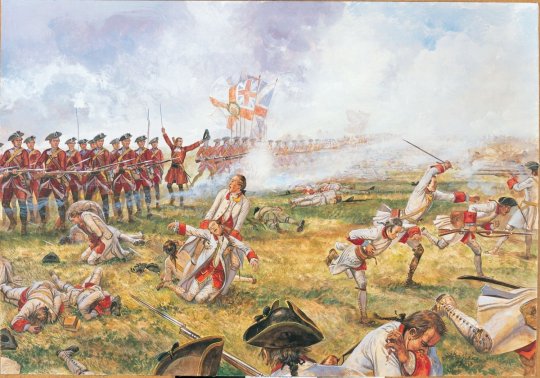
Wolfe, positioned with the 28th Foot and the Louisbourg Grenadiers, had moved to a rise to observe the battle; he had been struck in the wrist early in the fight, but had wrapped the injury and continued on. Volunteer James Henderson, with the Louisbourg Grenadiers, had been tasked with holding the hill, and reported afterwards that within moments of the command to fire, Wolfe was struck with two shots, one low in the stomach and the second, a mortal wound in the chest. Knox wrote that one of the soldiers near Wolfe shouted "They run, see how they run." Wolfe, on the ground, opened his eyes and asked who was running. Upon being told that the French had broken, he gave several orders, then turned on his side and said "Now, God be praised, I will die in peace", and died.
With Wolfe dead and several other key officers injured, British troops fell into a disorganised pursuit of the retreating French troops. The 78th Fraser Highlanders were ordered by Brigadier-General James Murray to pursue the French with their swords, but were met near the city by a heavy fire from a floating battery covering the bridge over the St. Charles River as well as militia that remained in the trees. The 78th took the highest number of casualties of all British units in the battle.
An eyewitness with the 78th Highlanders (Dr. Robert Macpherson) wrote three days after the battle:
The Highlanders pursued them to the very Sally Port of the town. The Highlanders returned towards the main body. When the highlanders were gathered together, they lay'd on a separate attack against a large body of Canadians on our flank that were posted in a small village and a Bush of woods. Here, after a wonderful escape all day, we suffered great loss both in Officers and men but at last drove them under the cover of their cannon which likeways did us considerable loss.
Townshend took charge of the British forces and realised that Bougainville's column was approaching from the British rear, having taken some time to arrive from Cap Rouge. He quickly formed up two battalions from the confused troops on the field and turned them to meet the oncoming French, a day-saving manoeuvre; instead of attacking with a well rested and ready force, Bougainville retreated while the rest of Montcalm's army slipped back across the St. Charles.
During the retreat, Montcalm, still mounted, was struck by either canister shot from the British artillery or repeated musket fire, suffering injuries to the lower abdomen and thigh. He was able to make it back into the city, but his wounds were mortal and he died at the wee hours the next morning. A few moments before he drew his last breath, Montcalm asked his surgeon how much time he had to live. "A few hours," he was answered. "All the better," he said, "I will not see the British in Quebec." He was buried in a shell crater left in the floor of the Ursuline chapel by a British shell. In terms of casualties the British suffered 658 killed or wounded, of these, sixty one officers and men were killed and 597 were wounded. The French had suffered more, losing from around 644 – 1,200 men killed or injured. They had also lost thirteen officers and 350 men taken prisoner.
In the wake of the battle, a state of confusion spread through the French troops. Governor de Vaudreuil, who later wrote to his government and put the full blame for the French rout on the deceased Montcalm, decided to abandon Quebec and the Beauport shore, ordering all of his forces to march west and eventually join up with Bougainville, leaving the garrison in Quebec under the command of Jean-Baptiste Nicolas Roch de Ramezay.
Meanwhile, the British, first under the command of Townshend and later with Murray in charge, settled in to besiege the city in conjunction with Saunders' fleet. Within days, on 18 September, de Ramezay, Townshend and Saunders signed the Articles of Capitulation of Quebec and the city was turned over to British control. The remaining French forces positioned themselves on the Jacques-Cartier River west of the city. The British Navy was forced to leave the St. Lawrence shortly after the capture of Quebec, lest pack ice close the mouth of the river.
The next April, before the ice left the rivers, the Chevalier de Lévis, Montcalm's successor as French commander, marched his 7,000 troops to Quebec. James Murray, the British commander, had experienced a terrible winter, in which scurvy had reduced his garrison to only 4,000. On 28 April 1760, Lévis' forces met and defeated the British at the Battle of Sainte-Foy, immediately west of the city (near the site of Université Laval today). This battle proved bloodier than that of the Plains of Abraham, with about 850 casualties on the French side and 1,100 on the British side. The French had defeated the British, but the British were able to withdraw within the walls of Quebec, to which the French laid siege. A lack of artillery and ammunition, combined with British improvements to the fortifications, meant that the French were unable to take the city by storm. Both sides awaited reinforcements from Europe. The first ships to arrive, in mid-May, were part of a British fleet which had defeated Levis' support ships.[50][68] The success of the French army's offensive against Quebec in the spring of 1760 had depended on the dispatch of a French armada, with fresh troops and supplies. A naval battle fought at Quiberon Bay, just off the coast of France, proved the decisive battle for this part of New France. The Royal Navy destroyed the French fleet, meaning France could not send a reserve force to save New France.
At Montréal that September, Lévis and 2,000 troops were confronted with 17,000 British and American troops. The French capitulated on 8 September 1760, and the British took possession of Montreal. The Treaty of Paris was signed in 1763 to end the war and gave possession of parts of New France to Great Britain, including Canada and the eastern half of French Louisiana—lying between the Mississippi River and the Appalachian Mountains.
#battle of the plains of abraham#quebec#battle of quebec#siege of quebec#history#military history#18th century#seven years war#7 years war#french and indian war#redcoat#redcoats#british army#james wolfe#general wolfe
75 notes
·
View notes
Note
Top 5 Halifax museums/area attractions?
Hello I am so sorry you must have sent this AGES ago but I am only now receiving it?? Thanks tumblr dot com!! ANYWAY without even further ado!!
1. Point Pleasant Park
I cannot recommend this spot enough. This is my favourite place to go in the entire city. You have the harbour, the forest, old forts and batteries (Cambridge Battery, the Prince of Wales martello tower to name a couple), and so many little coves and passageways to explore. There are cannons that have been left on the grounds from the days when Halifax was a garrison town, and if you're a cannon enthusiast like I am this is perfect for you!! There are also monuments like the Salior's Memorial, the anchor from the HMCS Bonaventure, and a commemorative cairn to celebrate the arrival of HMS Shannon with Chesapeake. You cannot have a bad time at Point Pleasant Park, especially when you can see harbour seals from the shore!! Here is a sample of what you can see from Sailor's Memorial Way

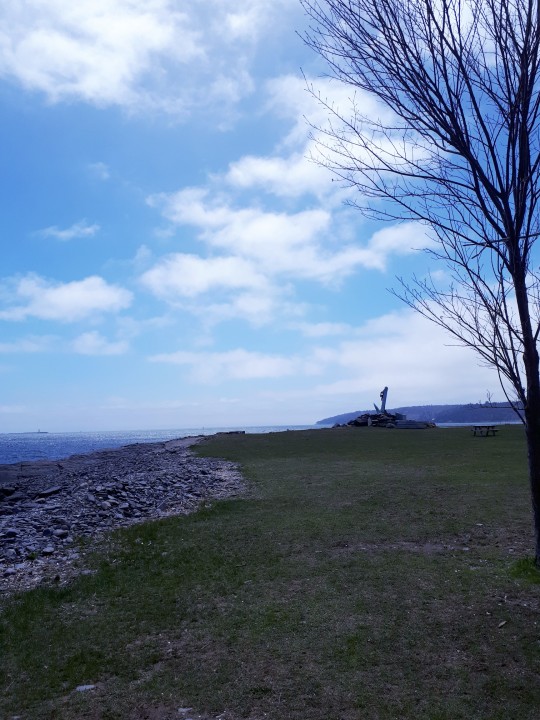
2. Maritime Museum of the Atlantic
Now this is THE museum I recommend to everyone. They've got the old lens from the Sambro Lighthouse (oldest light in North America!!), a lengthy exhibit on the Halifax Explosion, the history of seafaring and ships that Halifax has seen through the centuries, even a deck chair from the Titanic! And a Franklin display but sadly it's very small. Other artifacts include an iron cage from when pirates were hanged on Black Rock Beach (re: Point Pleasant Park), HMS Shannon's bell, Chesapeake's cooking kettle, a snuffbox made from Shannon's timbers, the figurehead from the Saladin (ship of the famous mutiny), and so so so much more. If you ever come to Halifax this is NOT a place to pass up!
3. Citadel Hill
Okay okay I know this one is super generic and EVERYONE comes here, but there is a good reason for that! There is HISTORY on this hill. First, there is a noon gun that fires every single day, it is funny to watch tourists jump at the sound but tbh I have been known to do so as well. This fort provides its visitors with reenactments of how life was inside its walls in 1867. In fact the rifles used by the sentries are actually from 1862! There's an army museum, a museum of Halifax from 1749-present, and plenty of tours one may find themselves on! There's even ghost walks during October, because it's also SUPER HAUNTED. So keep that in mind when you visit the Hill.
4. Camp Hill Cemetery/Old Burying Ground
Listen, if I'm gonna rec activities and sights there will inevitably be a cemetery or two on the list. First we have Camp Hill Cemetery, a huge Victorian graveyard that is the final resting place of such icons as Alexander Keith, Viola Desmond, and- who is that- Abraham Gesner, inventor of kerosene!! A walk through Camp Hill (across from the Black Window house of local folklore, @ghosstkid sound familiar? ;) ) is sure to satisfy your creepy side and is also quite charming, it is without a doubt one of the best spots in town.
The Old Burying Ground, also known as St. Paul's Cemetery, is the original cemetery for the city of Halifax since 1749. The graves in this cemetery are hundreds of years old and home to midshipman John Samwell and boatswain William Stevens of the Shannon, and even once was the temporary resting place of Chesapeake's captain Lawrence. There is so much history in this little plot (no pun intended) of land!
5. The Public Gardens
Yes yes another popular destination, but I promise you it's beautiful! Originally used as a landfill in Victorian times, the gardens have become a staple of regular city life. The flowers look as lovely as they smell, the ducks are always on the move, and the swans (yes the swans) are always preening! If youd like you can get a snack and refreshments from the Gardens' own cafe, and if you're lucky you can catch a live performance on the grounds or in the bandstand! Since this park is in the middle of a city block, it's a lovely shortcut to take and also right across from Camp Hill!
So basically what I'm saying is come experience Halifax
28 notes
·
View notes
Text
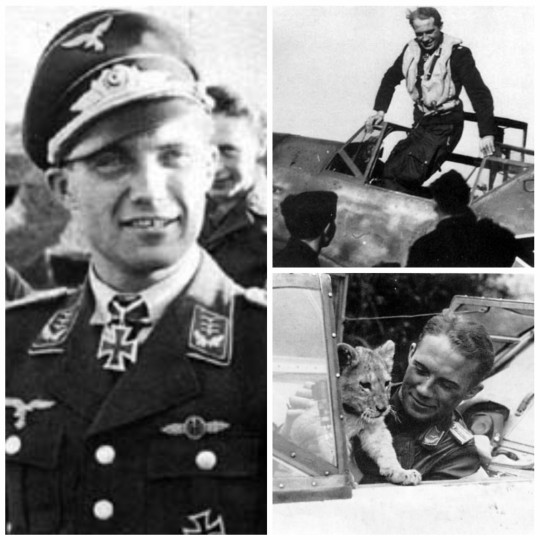
• Franz von Werra (Swiss Luftwaffe Ace)
Franz Xaver Baron von Werra was a German World War II fighter pilot and flying ace who famously was shot down over Britain and made several escape attempts from Allied POW camps.
Franz Baron von Werra was born on July 13th, 1914, to impoverished Swiss parents in Leuk, a town in the Swiss canton of Valais. The title of Freiherr (equal to Baron) came from his biological father, Leo Freiherr von Werra, who after bankruptcy, faced deep economic hardship. Because his relatives were legally obliged to look after the Baron's wife and six children, his cousin Rosalie von Werra persuaded her childless friend Louise Carl von Haber to permit the Baron's youngest, Franz and his sister, to enjoy the benefits of wealth and education. Werra joined the Luftwaffe in 1936 and was commissioned a Leutnant in 1938. At the beginning of the Second World War he was serving with Jagdgeschwader 3 in the French campaign. He became adjutant of II Gruppe, JG 3 and was described as engaging in boisterous 'playboy' behavior. He was once pictured in the press with his pet lion Simba, which he kept at the aerodrome as the unit mascot.
Werra scored his first four victories in May 1940, during the Battle of France. Downing a Hawker Hurricane on May 20th, two days later he claimed two Breguet 690 bombers and a Potez 630 near Cambrai. In a sortie on August 25th, during the Battle of Britain, he claimed a Spitfire west of Rochester, and three Hurricanes, as well as five destroyed on the ground for a total of nine RAF planes eliminated. The details of the actions are unknown, as the incident has not been found in British records. On September 5th, 1940, Werra's Bf 109E-4 was shot down over Winchet Hill, Kent. It is unclear who was responsible for this victory, which was originally credited to Pilot Officer Gerald "Stapme" Stapleton of No. 603 Squadron RAF. However, the Australian ace Flight Lieutenant Paterson Hughes was posthumously given half of the credit, awarding him a bar to his DFC. Werra crash-landed his Bf 109E-4 in a field on Loves Farm and was captured by the unarmed cook of a nearby army unit. Werra was initially held in Maidstone barracks by the Queen's Own Royal West Kent Regiment, from which he attempted his first escape.
He had been put to work digging and was guarded by RMP Private Denis Rickwood, who had to face Werra down with a small truncheon, while Werra was armed with a pick axe. He was interrogated for eighteen days at the London District Prisoner of War "cage" Trent Park, an country house in Hertfordshire. Eventually, Werra was sent on to POW Camp No.1, at Grizedale Hall in the Furness Fells area of pre-1974 Lancashire, between Windermere and Coniston Water. On October 7th, he tried to escape for the second time, during a daytime walk outside the camp. At a regular stop, while a fruit cart provided a lucky diversion and other German prisoners covered for him, von Werra slipped over a dry-stone wall into a field. The guards alerted the local farmers and the Home Guard. On the evening of October 10th, at around 11:00pm, two Home Guard soldiers found him sheltering from the rain in a hoggarth (a type of small stone hut used for storing sheep fodder that is common in the area). On being removed from the hut he knocked the lamp to the ground, extinguishing the light, then he quickly escaped and disappeared into the night. On October 12th, he was spotted climbing a fell. The area was surrounded, and Werra was eventually found, almost totally immersed in a muddy depression in the ground. He was sentenced to 21 days of solitary confinement and on November 3rd was transferred to Camp No. 13 in Swanwick, Derbyshire, also known as the Hayes camp.
In Camp No. 13, Werra joined a group calling itself Swanwick Tiefbau A.G. (Swanwick Excavations, Inc.), which was digging an escape tunnel. The tunnel can still be seen at the Hayes Conference Centre. On December 17th, 1940, after a month's digging, it was complete. The camp had forgers who equipped the escape group with money and fake identity papers. On December 20th, Werra and four others slipped out of the tunnel under the cover of anti-aircraft fire and the singing of the camp choir. The others were recaptured quickly, leaving Werra to proceed alone. He had taken along his flying suit and decided to masquerade as Captain van Lott, a Dutch Royal Netherlands Air Force pilot. He told a friendly locomotive driver that he was a downed bomber pilot trying to reach his unit, and asked to be taken to the nearest RAF base. At Codnor Park railway station, a local clerk became suspicious, but eventually agreed to arrange his transportation to the aerodrome at RAF Hucknall, near Nottingham. The police also questioned him, but Werra convinced them he was harmless. At Hucknall, a Squadron Leader Boniface asked for his credentials, and Werra claimed to be based at Dyce near Aberdeen. While Boniface went to check this story, Werra excused himself and ran to the nearest hangar, trying to tell a mechanic that he was cleared for a test flight. Boniface arrived in time to arrest him at gunpoint, as he sat in the cockpit, trying to learn the controls. Werra was sent back to the Hayes camp under armed guard.
In January 1941, Werra was sent with many other German prisoners to Canada on the Duchess of York, in a convoy departing Greenock on January 10th, 1941, guarded by HMS Ramillies among others. His group was to be taken to a camp on the north shore of Lake Superior, Ontario, so Werra began to plan his escape to the United States, which was still neutral at the time. On January 21st, while on a prison train that had departed Montreal, he jumped out of a window, again with the help of other prisoners, and ended up near Smith's Falls, Ontario, 30 miles from the St. Lawrence River. Seven other prisoners tried to escape from the same train, but were soon recaptured. Werra's absence was not noticed until the next afternoon. After crossing the frozen St. Lawrence River, Werra made his way to Ogdensburg, New York, arriving several months before the US entered the war, and turned himself over to the police. The immigration authorities charged him with entering the country illegally, so Werra contacted the local German consul, who paid his bail. Thus, he came to the attention of the press and told them a very embellished version of his story. While the U.S. and Canadian authorities were negotiating his extradition, the German vice-consul helped him over the border to Mexico. Werra proceeded in stages to Rio de Janeiro, Brazil, Barcelona, Spain and Rome, Italy. He finally arrived back in Germany on April 18th, 1941.
On his return to Germany Werra became a hero. Adolf Hitler awarded him the Knights Cross of the Iron Cross. Werra was assigned the task of improving German techniques for interrogating captured pilots, based on his experiences with the British system. Werra reported to the German High Command on how he had been treated as a POW, and this caused an improvement in the treatment of Allied POWs in Germany. He wrote a book about his experiences titled Meine Flucht aus England (My Escape from England), although it remained unpublished. Werra returned to active service with the Luftwaffe and was initially deployed to the Russian front as Gruppenkommandeur of I./JG 53. He scored 13 more aerial victories during July 1941, raising his overall confirmed total to 21. In early August 1941, I./JG 53 withdrew to Germany to re-equip with the new Bf 109F-4, after which it moved to Katwijk in the Netherlands. On October 25th, 1941 Werra took off in Bf 109F-4 Number 7285 on a practice flight. His aircraft suffered engine failure and crashed into the sea north of Vlissingen. Werra was presumed killed, though his body was never found.
#second world war#world war 2#world war ii#military history#history#wwii#german history#prisoner of war#battle of britain#biography
18 notes
·
View notes
Photo

“Return of the Giant”. HMS St. Lawrence, rounds Point Frederick and heads into Navy Bay accompanied by Prince Regent, Princess Charlotte, and Netley Sep 1814. by Peter Rindlisbacher
The HMS St Lawrence was the largest warship ever built on the Great Lakes during the age of sail. During the War of 1812, supply, reinforcement and the movement of troops for attack all depended on the naval control of the lakes. Early in the war the Americans were able to attack York and Fort George with impunity. Because Lake Ontario is effectively landlocked by Niagara in the west and the St Lawrence River rapids in the east, if warships were to operate on the lake, they needed to be built or assembled there.
The size and power of the St Lawrence were a result of the ambition of British naval commodore James Lucas Yeo. He had approval to build a smaller ship, but being far from his commanders in England, he greatly enlarged the ship. The keel was laid on 12 April 1814 at the Point Frederick shipyard in Kingston, Upper Canada. The triple-decker ship of the line was a monster of her time, more powerful even than Lord Nelson’s flagship Victory. It eventually carried 112 guns and a crew of 837 officers and seamen, most of whom had to be dispatched from Quebec City. HMS St Lawrence was launched 10 September 1814. In contrast to ocean-going vessels of the time, the ship had a shallow draft and was rather unstable. She was struck by lightning four days after her maiden voyage. Nevertheless, the ship served her purpose. She never saw action because she was such a deterrent.
After the war 1815 HMS St Lawrence was decommissioned and her hull used as storage for a local Kingston brewery since 1832. Later she was sunk close to shore in Kingston harbour, where she now serves as a popular diving attraction.
130 notes
·
View notes
Text
Jan 16 in WWI
Jan 16 1918
Q 59400 Gateway of the fort at Kalaat es Sebeil, six miles east of Wejh. Photo by Philby H St J B Part of the Lawrence T E (COLONEL) COLLECTION

Jan 16 1917
Chicago Tribune - Jan 16 1917
When attrition meets attrition
Who will bleed out first?
Attrition by land or sea?

Jan 16 1916
IWM (SP 501) “HMS ARK ROYAL hoisting a Short seaplane out of the water at Mudros”

Jan 16 1915
Italian car marker designs revolutionary car the A.L.F.A 40/60 HP Aerodinamica, can reach 80mph (130 km/h) - Bismarck daily tribune. (Bismarck, Dakota [N.D.])
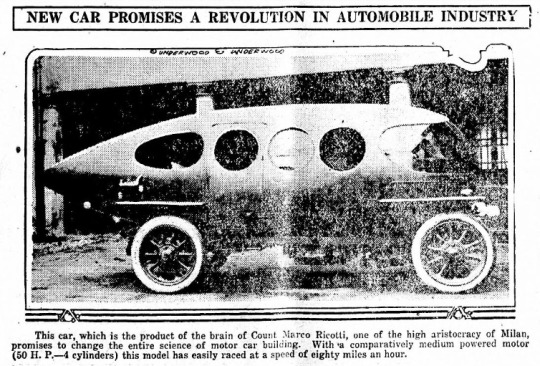

92 notes
·
View notes
Text
The War of Jenkins’ Ear
In the 1730's, British mariners were falling victim to abusive ship searches by Spanish coastguards around the West Indies. During a search of his ship in 1731, Spanish officers badly beat Captain Robert Jenkins and cut off his ear. Popular response to the incident was tepid until several years later, when opposition politicians and the British South Sea Company played it up, hoping to spur outrage against Spain, believing that a victorious war would improve Britain's trading opportunities in the Caribbean. In addition, the British wanted to keep pressure on Spain to honour their lucrative asiento contract, which gave British slave traders permission to sell slaves in Spanish America. The Spanish refer to this asiento in their name for this war.

Jenkins went before a House of Commons committee in 1739 to report the incident. That, along with the other mounting complaints about Spanish treatment, gave Prime Minister Sir Robert Walpole reason to declare war on the Spanish Empire in 1739.
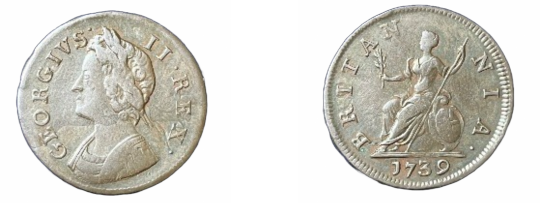
A plan was laid for combined operations against the Spanish colonies from east and west. One force, military and naval, was to assault them from the West Indies under Admiral Edward Vernon.

Vernon’s capture of Porto Bello was welcomed as an exceptionally popular triumph throughout Britain and America, and the name of Portobello came to be used in commemoration at a variety of locations, such as the Portobello Road in London, the Portobello district of Edinburgh and also in Dublin; as well as Porto Bello in Virginia and Porto Bello in St. Mary's County, Maryland. The victory was particularly well received in the North-American British colonies, where the Spanish had been preying on British shipping. George Washington's older half-brother Lawrence had served under Vernon, and named his estate Mount Vernon for his former commander.

Vernon's enduring claim to fame was his 1740 order that his sailors' rum should be diluted with water. In 1740, citrus juice (usually lemon or lime juice) was added to the recipe of the traditional daily ration of watered-down rum. Although they did not know the reason at the time, Admiral Edward Vernon's sailors were healthier than the rest of the navy, due to the daily doses of vitamin C the sailors received. However, it was not until 1747 that James Lind formally proved that scurvy could be treated and prevented by supplementing the diet with citrus fruit such as limes or lemons. The rest of the Royal Navy rapidly followed Vernon's lead, supposedly calling the new drink "grog" after Vernon's nickname "Old Grog", attributed to his habitual wearing of a grogram coat.
The other force in this war, to be commanded by Commodore George Anson, afterwards Lord Anson, was to round Cape Horn and to fall upon the Pacific coast of Latin America.
Anson was placed in charge of a squadron of six ships led by HMS Centurion and instructed to sail to Manila and capture the Spanish colony. A series of gales dispersed the ships of the fleet, and the crews were greatly reduced by scurvy and dysentery.
Only the Centurion reached Macau with 200 scurvy-ridden crew on 12 November 1742, and underwent a refit.
After 1742, the war was subsumed by the wider War of the Austrian Succession, which involved most of the powers of Europe until peace arrived with the Treaty of Aix-la-Chapelle in 1748.
Meanwhile Anson decided to cruise off the Philippines in the hope of intercepting Spanish treasure galleons, and on 20 June 1743 the galleon Nuestra Señora de Covadonga, carrying 1,313,843 pieces of eight and 35,682 oz of virgin silver, was sighted off Cape Espiritu Santo.

Anson returned to Canton where he sold his captured prize, and thence to England, where the Centurion arrived without further incident in June 1744. More than 1,300 members of the original expedition had perished, and 145 now remained to see England again.
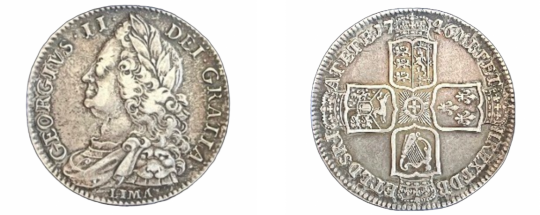
When Anson returned to England, it was decided that the captured silver would be turned into British coins. It was carried to the Royal Mint by many, many wagons, much to the delight of onlookers. The seized coins bore the word ‘Lima', the name of the Peruvian capital city where the metal for the coins was originally sourced. To mirror this, and to celebrate the capture of the silver, ‘Lima' was struck into King George II's silver issues of 1745 and 1746, underneath his portrait.

1 note
·
View note
Text
It Seems Like Nothing Changes
Paul Cussen
August 2018
In the last two weeks of Anglo-Welsh composer Philip Heseltine’s year long stay in Ireland, he writes ten songs which are published under the pseudonym Peter Warlock. These are considered to be among his finest work.
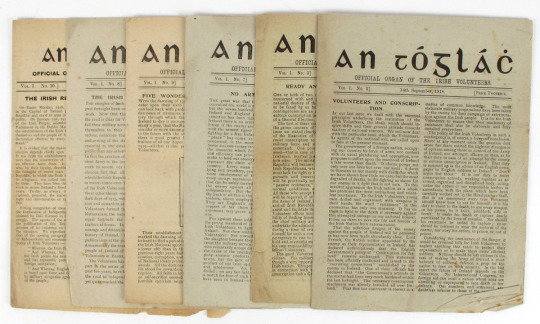
An t-Óglách, with the tagline ‘The Official Organ of the Irish Volunteer', often described as a successor to the Irish Volunteer, is published. It is published twice a month initially and successfully manages to remain in circulation despite numerous raids and having to operate in secret to avoid complete closure. Michael Collins, Adjutant General and Director of Organisation, is a regular contributor to the magazine.
Charlie Hurley is arrested on a charge of unlawful assembly and imprisoned in Cork Gaol. When arrested he is found to have in his possession documents relating to military installations in the Beara peninsula and a plan for destroying the police barracks in Castletownbere. On release from Cork Gaol he is rearrested, court-martialled and sentenced to five years' penal servitude at Maryborough (Portlaoise) Gaol.
John Hawkes from off-Barrack Street lodges an unsuccessful appeal with the local War Pensions Committee in Cork city, noting that he had been ‘awarded a pension of 8d. a day for 18 months final [sic] & his period expired some time ago. He states that if he could obtain a pair of spectacles, he would be employed at once as a watchmaker. He has no home and no money and will have to go to the workhouse if his appeal fails.’ Hawkes had previously served in the Royal Munster Fusiliers in France but had been discharged in April 1915, according to his mother, ‘because he got a bad cold in the trenches’ and had been declared ‘unfit for further duty’. Doctors at a hospital in Boulogne had determined that Hawkes suffered from a ‘mental deficiency’ .
Acting Major Thomas Marshal Llewellyn Fuge is mentioned in Despatches. He is mentioned in ‘Long Shadows by de Banks: the history of Cork County Cricket Club’ by Colm Murphy as a useful fast medium bowler who played for Ireland.
Stephen O’Callaghan of 39 Bandon Road completes four years on active duty with the Worcestershire Regiment and the Royal Munster Fusiliers, a recipient of the British Army Service Medal and the Victory Medal.
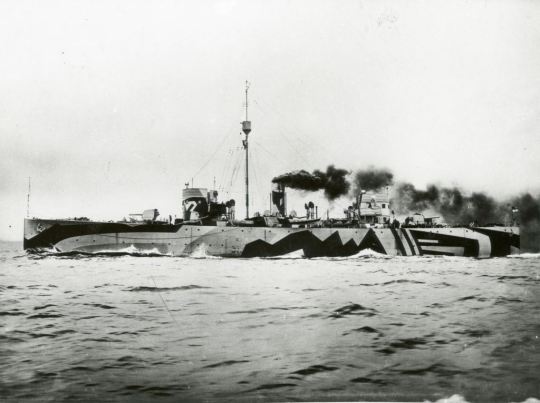
HMS Flying Fox takes over kite balloons and the operations are attached to the deployment of the American battleships Utah, Nevada and Oklahoma. The three battleships operate from Berehaven from August to October to protect Allied convoys from attack by the German battlecruisers.
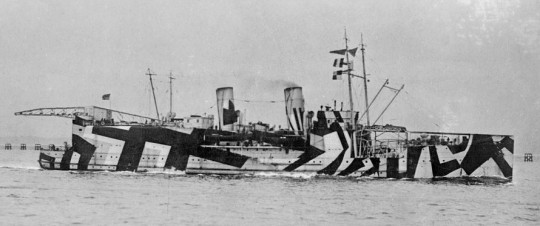
August 1 – The first fully combined air, sea, and land military operation in history is launched as RN Fairey Campania seaplanes from HMS Nairana join Allied forces to drive Red Army forces from the mouth of the Northern Dvina river in Russia.
The French Tenth Army launch an attack and penetrate five miles into German territory in the Second Battle of the Marne.
British troops enter Vladivostok.
August 2 – Captain Georgi Chaplin stages a coup against the local Soviet government of Arkhangelsk.
Japan announces that it is deploying troops to Siberia.

The first general strike in Canada occurs in a one-day protest at the murder of Albert “Ginger” Goodwin.
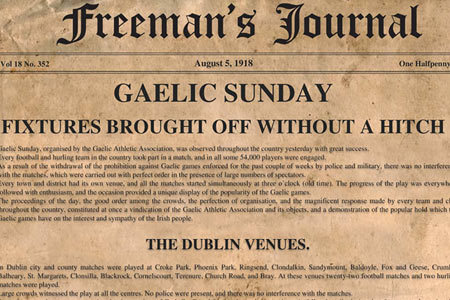
August 4 – ‘Gaelic Sunday’, approximately 100,000 Gaels take part in an act of defiance against the British administration by refusing to apply for licenses to play Gaelic Games.
Noel Willman, actor and theatre director, is born in Derry.
There is a full muster of the members of the companies of the Third West Cork Brigade for the funeral of Lieutenant William Hurley (Kilbrittain Company) in Clogagh.
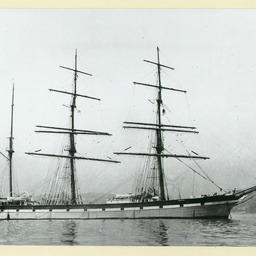
The Norwegian barque Remonstrant is sunk in the Atlantic Ocean 280 nautical miles (520 km) west of the Fastnet Rock. Her crew survive.
Adolf Hitler is awarded an Iron Cross first class on recommendation of his Jewish superior Lieutenant Hugo Gutmann.
August 5 – Five Zeppelins attempt to bomb London however most of the bombs fall into the North Sea due to heavy cloud cover and L20 is shot down killing all the crew.
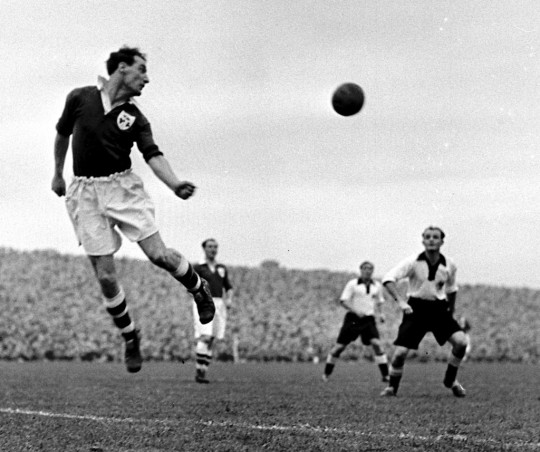
August 7 – Florrie Burke is born. He goes on to play for Cork United, Cork Athletic, Evergreen United, Ireland and the League of Ireland XI (d. 1995).
August 8 – The first organised meeting of the I.T.G.W.U. in Mallow is held this evening in the old Town-Hall.
Battle of Amiens where Canadian and Australian troops begin a string of almost continuous victories, the 'Hundred Days Offensive', with an 8-mile push through the German front lines, the Canadians and Australians capture 12,000 German soldiers, while the British take 13,000 and the French capture another 3,000 prisoners (more enemy troops were captured in the six days from August 6 to August 12 than in the previous nine months combined). German General Erich Ludendorff later calls this the "black day of the German Army". Historian Charles Messenger refers to this date as the “day we won the war”.

August 10 – General Frederick Poole, the British commander in Archangel, is told to help the White Russians.
August 16 – Battle of Lake Baikal is fought by the Czechoslovak legion against the Red Army. Red army forces take Arkhangelsk.

August 17 – Moisei Uritsky, the Petrograd head of the Cheka, is assassinated.
Wilfred Owen and Siegfried Sassoon meet for the last time, in London, and spend what Sassoon later describes as "the whole of a hot cloudless afternoon together”. British troops attack Baku, Azerbaijan
August 21 – The Second Battle of the Somme begins. Corporal Thomas Hargroves, Royal Irish Regiment, 2nd Batallion, dies in action. He had come from Laois to serve in the Prison Service in Cork and enlisted for military service in early 1916. He first saw action securing positions in Dublin in 1916. His unit landed in France in August 1916. He is listed on the Vis-En-Artois Memorial, (and on a memorial which disappeared from St. Peter’s Church between 2002 and 2006).

August 22 – Sergeant John Hallinon is killed in action in the Somme. He was born around 1883 in Ballincollig and was working as a bank messenger in London. His wife, Emily, unaware of the condition of life in the trenches wrote to ask for her husband's ring, wristwatch and pipes. They had one child, William.
August 23 – Creation of the Bessarabian Peasants' Party.
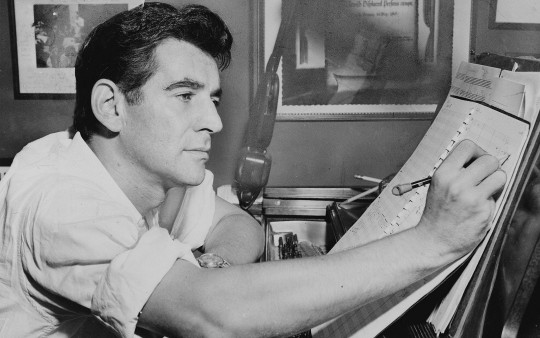
August 25 – Composer, conductor, author, music lecturer, and pianist Leonard Bernstein is born in Lawrence, Massachusetts (d. 1990).
70 year old fisherman William Whelton dies in Courtmacsharry after mistakenly consuming poison (unlike poisonings in the UK a century later there is no suspicion of Russian involvement!)
August 27 – Denis O'Doherty, Irish Guards is killed in action aged 28. His brother Felix O'Doherty had started the Fianna and Volunteers in Blarney and became Captain 'B' (Blarney) Company, 6th Battalion, Cork Brigade, I.R.A.
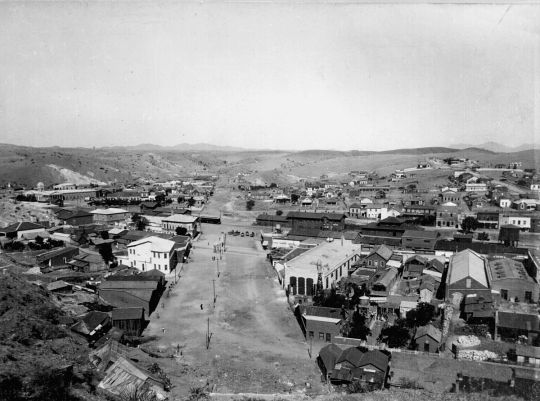
The Battle of Ambos Nogales occurs when U.S. Army forces skirmish against Mexican Carrancistas and two supposed German advisors at Nogales, Arizona, in the only battle of WWI fought on United States soil. Over 130 people die, the majority are Mexican citizens.
August 29 – Science historian and cryptanalyst John Herival is born in Belfast (d. 2011).
Bob Conklin dies of gunshot wounds, sustained at the Battle of Arras. Due to the delay of mail from the Front, his family still continue to receive letters from Bob after learning of his death: “Give my love to all and don’t worry on my account”; “Well, my news is finished, so I’ll ring off. I will write mother in a few days. Love to all. Bob.”
August 30 – Czechoslovakia forms independent republic.
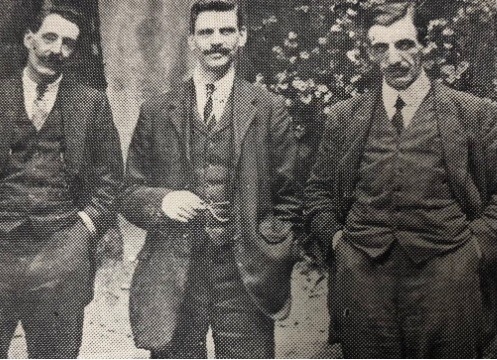
London Policemen go on strike after the dismissal of PC Tommy Thiel (centre in the photograph) for union membership. The strikers demand union recognition and a wage increase. Within a few hours 6,000 men throughout London are out, with more joining all the time; even the Special Branch is affected.
Vladimir Lenin is shot and wounded by Fanny Kaplan in Moscow.
4 notes
·
View notes
Text
The Battle of Halifax

During the American Revolution, Americans regularly attacked Nova Scotia by land and sea. American privateers devastated the maritime economy by raiding many of the coastal communities, such as the numerous raids on Liverpool and on Annapolis Royal.
The engagement between Jack and Observer was one of several in the region. On 10 July 1780, the British privateer brig Resolution (16 guns) under the command of Thomas Ross engaged the American privateer Viper (22 guns and 130 men) off Halifax at Sambro Light. In what one observer described as "one of the bloodiest battles in the history of privateering", the two privateers began a "severe engagement" during which both pounded each other with cannon fire for about 90 minutes. The engagement resulted in the surrender of the British ship and the death of up to 18 British and 33 American sailors.
Jack herself was involved in a previous naval engagement. Jack (or Saucy Jack) was originally a Massachusetts privateer commissioned in September 1779. After three successful cruises in which she captured a number of prizes, HMS Pandora and HMS Danae captured her in July 1780 in the St. Lawrence River. The British took Jack into the Quebec Provincial Marine, though she was commissioned out of Nova Scotia. She then served as a patrol vessel for the fisheries and the St. Lawrence River. In an engagement off Cape Breton with two French frigates at Spanish River, near Cape Breton Island in 1781 two French frigates captured her. They took Jack back to Boston, where her previous owners purchased her and sent her to sea again as a privateer.
Observer was herself a former Massachusetts privateer, originally built as a merchantman, the Amsterdam, which HMS Amphitrite captured on 19 October 1781. The British sent Amsterdam into Halifax to be condemned as a prize, where the Royal Navy bought her.
Observer was returning to Halifax, having rescued from American privateer Noah Stoddard ten crew members of HMS Blonde after Blonde wrecked on Seal Island off Cape Sable Island. On 28 May 1782, as Observer arrived at the Sambro Island Light near the mouth of Halifax Harbour, Jack approached her. When Jack discovered her quarry was a British naval vessel, the Americans tried to escape.
Observer chased Jack for two hours before catching her. The ships were evenly matched. The British immediately killed the American captain David Ropes as a result of the cannon fire. Both ships had numerous holes shot through their sails, and the British sailors attempted to climb the rigging of their ship in an effort to board the American privateer. The Americans repulsed this initial boarding attempt, but the British were ultimately successful. Jack struck her colours on the afternoon of 29 May.
#american revolution#revwar#american war of independence#history#royal navy#military history#18th century#tall ships#age of sail
95 notes
·
View notes
Text
Shannon vs. Chesapeake
Think of all the things you can do in 15 minutes. You can eat a snack, take a shower, do some quick exercises, do a face mask, it’s really up to you. I think I’ll use a pasta meal prep for this purpose, as it’s something I frequently do in 15 minutes. In the grand scheme of things, it isn’t a lot of time, but this of course depends on what it is you’re doing in 15 minutes. The first of June, 1813, saw one of the bloodiest and shortest naval battles in history- it lasted just under 15 minutes. I’m going to walk you through the history of those 15 minutes- today we’ll be travelling 207 years to the past, off the coast of Boston. Mind the cannonballs.

Now the Chesapeake so bold, sailed from Boston we’ve been told, for to take the British frigate neat and handy-o The people in the port all came out to see the sport And the bands were playing Yankee Doodle Dandy-o
The British frigate’s name, which for the purpose came to cool the Yankee courage neat and handy-o Was the Shannon: Captain Broke All her men were hearts of oak And at fighting were allowed to be the dandy-o
HMS Shannon was a Leda-class frigate, a lady built for war with an armament consisting of 38 guns numeric and 52 guns in actuality at the time of her 1813 battle. She was built in 1806 at Frindsbury and completed at Chatham, Kent. Captain Phillip Bowes Vere Broke would command her from her launch up until her infamous battle in the War of 1812. Broke ran a tight ship, his crew was extremely disciplined and would participate in daily drill exercises which made them sharp-eyed and fast-handed. Among Shannon’s victories was the 1808 capture of the French ship Thétis (she later became HMS Brune), however this was not her most memorable capture.
USS Chesapeake was a 38-gun frigate much like Shannon, commanded by Captain James Lawrence. She was slightly older and larger than Shannon and was just as powerful. During the War of 1812 she was quite successful, capturing several British merchant ships and ready to take more. How convenient it was for Shannon to be patrolling the Boston coast the same evening as Chesapeake.
It’s the first of June, 1813. Shannon is running low on provisions, yet eager to take one more American ship. Our fiery Captain Broke had his eyes on Chesapeake, and sent out a message to Captain Lawrence challenging him to an exchange of broadsides. Lawrence never received this message. When Shannon and Chesapeake met at half past five in the evening, they entered into something of a standoff, ending just before six o’clock that same evening. Note: this would be a good time to start our pasta.
As we’re boiling the water, Shannon fires the first shot into a gunport on Chesapeake. Her fire was deadly. She was carrying 32-pounder carronades which fired into her opponent’s helm and foremast, then Chesapeake was blown into Shannon; her stern colliding near Shannon’s bow and becoming trapped on her anchor.
The fight, it scarce begun, ‘ere they flinched from their guns Which at first they started working neat and handy-o Then brave Broke, he waved his sword, crying “Now, my lads, aboard! And we’ll stop their playing Yankee Doodle Dandy-o!”
The pasta has now begun to cook. Before Shannon’s crew boarded Chesapeake, Captain Lawrence was shot and killed by a sniper. The Shannons are now boarding the American ship (whose crew had “flinched” under fire) on the order of Captain Broke. Mr. William Stevens, Shannon’s boatswain, lost his arm in his attempt. He would later die of his injuries. Aboard Chesapeake it was hand-to-hand combat between the opposing sides. While it seemed the rest were distracted, Shannon’s First Lieutenant Watts made an attempt to raise the British colours on Chesapeake, but his efforts were futile: he was shot in the head and killed. Another of Shannon’s officers, midshipman John Samwell, was shot in the leg and succumbed to his injuries later.
They no sooner heard the word than they quickly jumped aboard And hauled down the Yankee colours, neat and handy-o Notwithstanding all their brag, now the glorious British flag At the Yankee mizzen peak was quite the dandy-o
Let’s chop some veggies now. Chesapeake’s crew outnumbered the Shannons and wanted to use this to their advantage. A few American sailors snuck up on Broke, one of whom he managed to kill before sustaining a critical head wound at the hand of another. With Shannon’s First Lieutenant dead and her captain in grave danger, command of the vessel fell to 22-year-old Second Lieutenant Provo Wallis, a Halifax native who spent his life in the Navy. He was going to bring her home.
Here’s a health, brave Broke, to you, to your officers and crew Who aboard the Shannon frigate fought so handy-o
It’s time to start the sauce. From my understanding as a non-American, the slogan of the American Navy is “Don’t Give Up the Ship,” which, of course, are the dying words of Captain Lawrence. Chesapeake’s casualties vastly outnumbered Shannon’s, and when the American sailors realised they could stand no more chance, they surrendered their ship.
By now, our pasta is finished and so is the battle. Now-Commander Provo Wallis sailed his ship quickly and quietly back to Halifax- she was badly injured and could not risk being seen by another American ship- with the Chesapeake in tow as the prize. They made it to Halifax Harbour on the morning of the 6th of June, a Sunday. St. Paul’s Church, which today is the oldest still-standing structure in Halifax, was filled with its congregation. Word caught on that an American ship was taken and that a Haligonian was at the victor’s helm, and within minutes the entire church was emptied as civilians rushed to the water. The sight of the captured Chesapeake arriving before Shannon incited a rupture of cheers and celebration from the huge crowd gathered at the waterfront, a celebration which has yet to be matched.

The tale of the Shannon and the Chesapeake, the Battle of Boston Harbour, is as infamous as it is because it caused so much bloodshed in so little time. It is Halifax folklore that at the north side of Province House sits one of Shannon’s guns (note: I researched this and found the gun to be too large). Provo Wallis, the young officer from Halifax, was celebrated as a city icon and would later be promoted to Admiral of the Fleet, living to the age of 100. Boatswain Stevens and midshipman Samwell are both buried in Halifax’s Old Burying Ground, their headstone can still be seen in the foyer of St. Paul’s Church. Captain Broke later recovered from his injuries and would go on to command another vessel, a little bomb ship by the name of HMS Erebus.
#hms shannon#hms chesapeake#war of 1812#battle of boston harbour#halifax#god i hope that read more works#it's shannon day!!!
87 notes
·
View notes